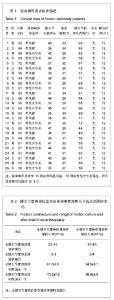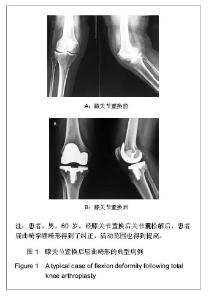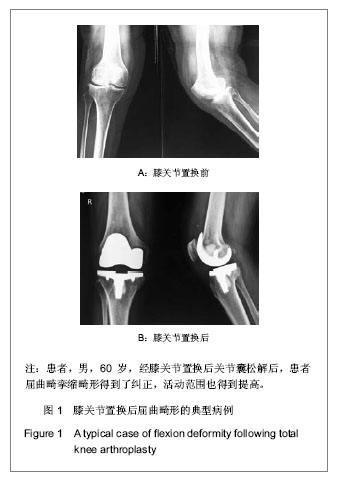| [1] Aglietti P, Windsor RE, Buzzi R, et al. Arthroplasty for the stiff or ankylosed knee. J Arthroplasty. 1989;4(1):1-5.
[2] Engh GA. Medial epicondylar osteotomy: a technique used with primary and revision total knee arthroplasty to improve surgical exposure and correct varus deformity. Instr Course Lect. 1999;48:153-156.
[3] Naudie DD, Rorabeck CH. Managing instability in total knee arthroplasty with constrained and linked implants. Instr Course Lect. 2004;53:207-215.
[4] Jenny JY. The current status of computer-assisted high tibial osteotomy, unicompartmental knee replacement, and revision total knee replacement. Instr Course Lect. 2008;57:721-726.
[5] Younger AS, Duncan CP, Masri BA. Surgical exposures in revision total knee arthroplasty. J Am Acad Orthop Surg. 1998; 6(1):55-64.
[6] Preston CF, Fulkerson EW, Meislin R, et al. Osteotomy about the knee: applications, techniques, and results. J Knee Surg. 2005;18(4):258-272.
[7] McAuley JP, Engh GA, Ammeen DJ. Treatment of the unstable total knee arthroplasty. Instr Course Lect. 2004;53: 237-241.
[8] Morgan H, Battista V, Leopold SS. Constraint in primary total knee arthroplasty. J Am Acad Orthop Surg. 2005;13(8): 515-524.
[9] Clarke HD, Scuderi GR. Revision total knee arthroplasty: planning, management, controversies, and surgical approaches. Instr Course Lect. 2001;50:359-365.
[10] Steinhauser E, Burgkart R, Gerdesmeyer L. Biomechanical aspects of revision components for knee arthroplasty. Orthopade. 2006;35(2):128-135.
[11] Hoeffel DP, Rubash HE. Revision total knee arthroplasty: current rationale and techniques for femoral component revision. Clin Orthop Relat Res. 2000;(380):116-132.
[12] Firestone TP, Krackow KA, Davis JD 4th, et al. The management of fixed flexion contractures during total knee arthroplasty. Clin Orthop Relat Res. 1992;(284):221-227.
[13] Lizaur A, Marco L, Cebrian R. Preoperative factors influencing the range of movement after total knee arthroplasty for severe osteoarthritis. J Bone Joint Surg Br. 1997;79(4):626-629.
[14] Bauer T, Biau D, Colmar M, et al. Influence of posterior condylar offset on knee flexion after cruciate-sacrificing mobile-bearing total knee replacement: a prospective analysis of 410 consecutive cases. Knee. 2010;17(6):375-380.
[15] Lu H, Mow CS, Lin J. Total knee arthroplasty in the presence of severe flexion contracture: a report of 37 cases. J Arthroplasty. 1999;14(7):775-780.
[16] Carstens C, Schmidt E, Fromm B, et al. Results of surgical therapy of knee flexion contractures in patients with myelomeningocele. Z Orthop Ihre Grenzgeb. 1992;130(3): 207-212.
[17] Sculco TP. The knee joint in rheumatoid arthritis. Rheum Dis Clin North Am. 1998;24(1):143-156.
[18] Rahmé M, Ehlinger M, Faradji A, et al. Total knee arthroplasty in severe haemophilic patients under continuous infusion of clotting factors. Knee Surg Sports Traumatol Arthrosc. 2012; 20(9):1781-1786.
[19] Warner JJ. The Judet quadricepsplasty for management of severe posttraumatic extension contracture of the knee. A report of a bilateral case and review of the literature. Clin Orthop Relat Res. 1990;(256):169-173.
[20] Ga?dzik T. Possibilities of surgical treatment of knee joint in rheumatoid arthritis patients. Wiad Lek. 1998;51(11-12): 518-524.
[21] Hayakawa K, Yamada H. Replacement arthroplasty for patients with rheumatoid arthritis. Clin Calcium. 2012;22(2): 237-243.
[22] Kim SJ, Choe WS. Pathological infrapatellar plica: a report of two cases and literature review. Arthroscopy. 1996;12(2): 236-239.
[23] Maral T, Tuncali D, Ozgür F, et al. A case of popliteal pterygium treated along with nerve expansion. Plast Reconstr Surg. 1997;100(1):91-95.
[24] Brattström H, Moritz U. Treatment of knee joint contractures. Lakartidningen. 1971;68(48):5591-5596.
[25] McPherson EJ, Cushner FD, Schiff CF, et al. Natural history of uncorrected flexion contractures following total knee arthroplasty. J Arthroplasty. 1994;9(5):499-502.
[26] Mihalko WM, Krackow KA. Posterior cruciate ligament effects on the flexion space in total knee arthroplasty. Clin Orthop Relat Res. 1999;(360):243-250.
[27] Engh GA, Ammeen D. Results of total knee arthroplasty with medial epicondylar osteotomy to correct varus deformity. Clin Orthop Relat Res. 1999;(367):141-148.
[28] Ranawat CS, Rose HA, Rich DS. Total condylar knee arthroplasty for valgus and combined valgus-flexion deformity of the knee. Instr Course Lect. 1984;33:412-416.
[29] Kwan MK, Penafort R, Saw A. Treatment for flexion contracture of the knee during Ilizarov reconstruction of tibia with passive knee extension splint. Med J Malaysia. 2004;59 Suppl F:39-41.
[30] Su EP. Fixed flexion deformity and total knee arthroplasty. J Bone Joint Surg Br. 2012;94(11 Suppl A):112-115.
[31] Bremer D, Orth BC, Fitzek JG, et al. Briard's sagittal sliding osteotomy of the lateral condyle in total knee arthoplasty of the severe valgus knee. Oper Orthop Traumatol. 2012;24(2): 95-108.
[32] 畅怡,周殿阁.初次全膝关节置换术中韧带加强技术的应用[J].中华医学杂志,2009,89(21):1509-1511.
[33] 姚建锋,卿忠,秦四清,等.屈曲挛缩畸形的膝关节置换术[J].美中国际创伤杂志,2012,11(1):36-37.
[34] 王维军,牛东生. 重症类风湿性关节炎膝关节屈曲挛缩畸形全膝关节置换术的软组织平衡[J].中国修复重建外科杂志,2008, 22(10): 1173-1176.
[35] 王友,朱振安,史定伟,等. 膝关节屈曲挛缩畸形全膝关节置换术的软组织平衡[J].中华骨科杂志,2004,24(4):220-223.
[36] 李宝军,邓展生,朱峥嵘,等.全膝关节置换治疗膝屈曲内翻畸形的软组织平衡[J].中国现代医学杂志, 2011,21(17):2038-2042.
[37] 张洪美,陈卫衡,赵铁军,等.全膝人工关节置换术中软组织紧张分类及处理[J].中国骨伤,2004,17(12):717-719.
[38] 喻长纯,王战朝,尚延春,等.膝关节内翻屈曲畸形全膝关节置换的软组织平衡[J].中国修复重建外科杂志,2007, 21(10):1062- 1066.
[39] 关振鹏,吕厚山,石明国,等.不同程度屈膝挛缩畸形人工全膝关节置换的早期疗效比较[J].中国修复重建外科杂志,2006,20(6): 598-601.
[40] 冯灿林,黎泽森,黎霭云,等.膝关节置换在膝关节内翻畸形中的应用研究[J].重庆医学,2013,42(11):1229-1230.
[41] 汪学松,高增鑫,李佳意,等.膝关节置换术中膝外翻的生物力学分析[J].中国组织工程研究与临床康复,2008,12(4):752-754.
[42] 陈成亮,宋树春,邹士平,等.软组织平衡在膝屈曲内翻畸形膝关节置换术中的应用[J].中外医疗,2010,29(34):66.
[43] 潘文杰,刑科,贺艳,等.膝关节内翻屈曲畸形全膝关节置换的早期疗效[J].中国骨与关节损伤杂志,2011, 26(7):595-597.
[44] 谭光华.膝关节内翻屈曲畸形全膝关节置换的软组织平衡技巧[J].求医问药(学术版),2012,10(11):772.
[45] 朱国兴,杨玉生,施克勤.人工全膝关节表面置换术中后关节囊切断松解的应用[J].江苏医药,2007,33(9):877-879.
[46] 卢世璧,张子军.通用手术器械行全髁关节置换//葛宝丰,卢世璧.手术学全集:矫形外科卷[M].北京:人民军医出版社,1996: 1004-1013.
[47] Bäthis H, Perlick L, Tingart M, et al. Flexion gap configuration in total knee arthroplasty following high tibial osteotomy. Int Orthop. 2004;28(6):366-369.
[48] Mihalko WM, Krackow KA. Posterior cruciate ligament effects on the flexion space in total knee arthroplasty. Clin Orthop Relat Res. 1999;(360):243-250.
[49] Whiteside LA, Mihalko WM. Surgical procedure for flexion contracture and recurvatum in total knee arthroplasty. Clin Orthop Relat Res. 2002;(404):189-195.
[50] Mihalko WM, Krackow KA. Posterior cruciate ligament effects on the flexion space in total knee arthroplasty. Clin Orthop Relat Res. 1999;(360):243-250.
[51] 王晓峰,陈百成.影响全膝关节置换术后膝关节活动度的因素[J].中国矫形外科杂志,2008,16(15):1156-1160. |



